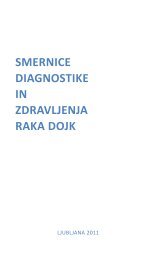You also want an ePaper? Increase the reach of your titles
YUMPU automatically turns print PDFs into web optimized ePapers that Google loves.
Do organophosphorous pesticides play a role<br />
in cancer development?<br />
Irena Hreljac, Irena Zajc, Bojana @egura, Tamara T. Lah, Metka Filipi~<br />
Department of Genetic Toxicology and Cancer Biology, National Institute of Biology,<br />
Ljubljana, Slovenia<br />
Organophosphorous (OP) pesticides have been widely used worldwide to help<br />
boost agricultural production. Some OP compounds have also been used as warfare<br />
agents. OPs irreversibly inhibit acetylcholine esterase and this property is exploited<br />
for their use as insecticides and as warfare agents. Although the effects and the<br />
consequences of acetylcholine esterase inhibition on the nervous system have<br />
been extensively studied, very little is known about possible chronic effects of OP<br />
pesticides on non-target tissues in humans. Long term exposure to OP pesticides<br />
has been associated with higher risk of Non-Hodgkin’s lymphoma and different<br />
leukaemias. Our main aim was to investigate whether low concentrations of OP<br />
pesticides can cause DNA damage in non-target human cells and affect expression<br />
of certain genes known to be involved in cancer development.<br />
Three OP pesticides – parathion, paraoxon and dimefox were studied in human<br />
hepatoma HepG2 cell line as in vitro human cell model. With the comet assay, we<br />
investigated whether the sub-cytotoxic concentrations of OP pesticides (determined<br />
by MTT assay) can induce DNA damage. Dimefox did not increase the level of<br />
strand brakes at any used concentration; parathion and paraoxon showed slightly<br />
increased level of strand breaks only at highest concentration used (100 µg/ml).<br />
Using RT-PCR, we found that exposure of HepG2 cells to parathion and paraoxon<br />
caused a signifficant increase of the expression of genes that are involved in<br />
response to genotoxic stress: P53, MDM2 and GADD45. Dimefox did not significantly<br />
change the expression of MDM2 or GADD45, whereas at the highest concentration<br />
(100 µg/ml) increased P53 expression. This data indicate that in contrast to dimefox,<br />
parathion and paraoxon may have some genotoxic potential<br />
We further investigated the influence of the pesticides on cell proliferation of HepG2<br />
cells. Exposure to dimefox for up to 92 hours increased cell proliferation at all<br />
concentrations (0,01 to 100 µg/ml) used. This implies that dimefox could be a<br />
potential tumour promoting agent.<br />
In conclusion, this study has shown that OP pesticides may affect tumour development<br />
through different mechanisms. Their presence in our environment calls for further<br />
investigation of their potential long-term deleterious effects to human health.<br />
p1485

















